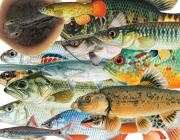The Edwards Aquifer is likely the world's most diverse groundwater ecosystem, largely because of all the invertebrates it harbors, and diverse invertebrates live in all of the same aquifers in which we study blindcats. We collected amphipods, isopods, snails and other inverts (including some previously undescribed species) during our early work in Coahuila and Tamaulipas, and all those specimens landed in our Cave Invertebrate Collection, curated by James Reddel, in the same building with the Fish Collection. Generally, not only only are specimens of those invertebrates much more easy to come by than are blindcat specimens, so good numbers of specimens already exist in collections, but unlike fish specimens, they have useful DNA since they are not preserved in formalin. By combining systematic studies of both fishes and invertebrates, we'll be able to learn much more about aquifers and their ecosystems than if we focus only on fishes. So, we're hoping to do just that, as reflected in recent proposals and presentations from the Blindcat Working Group.

